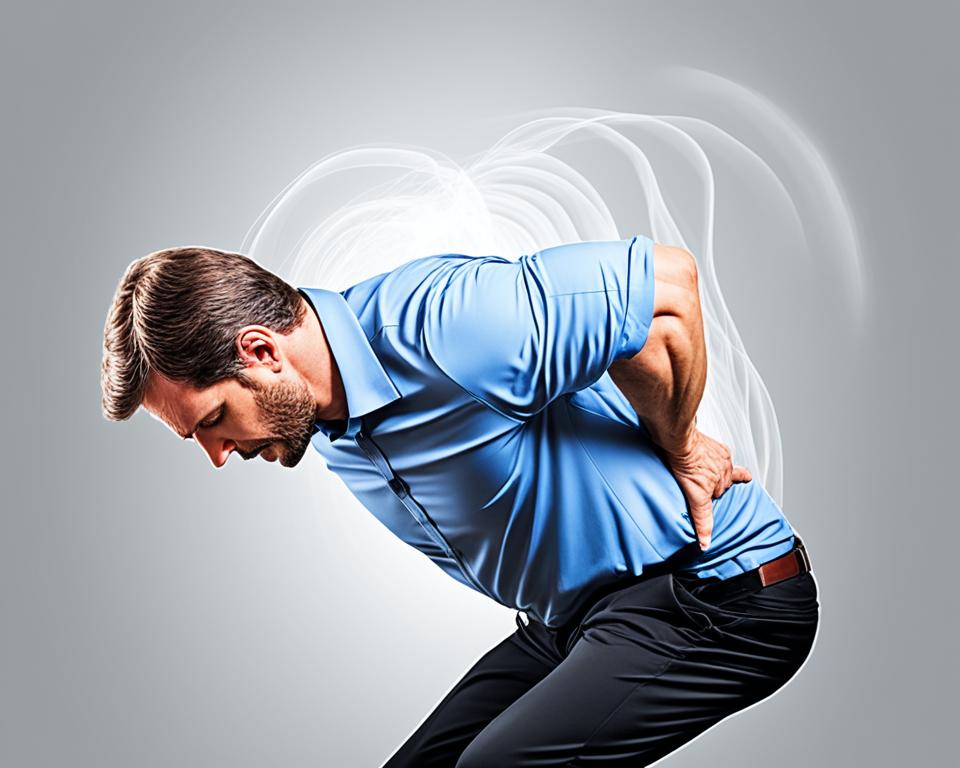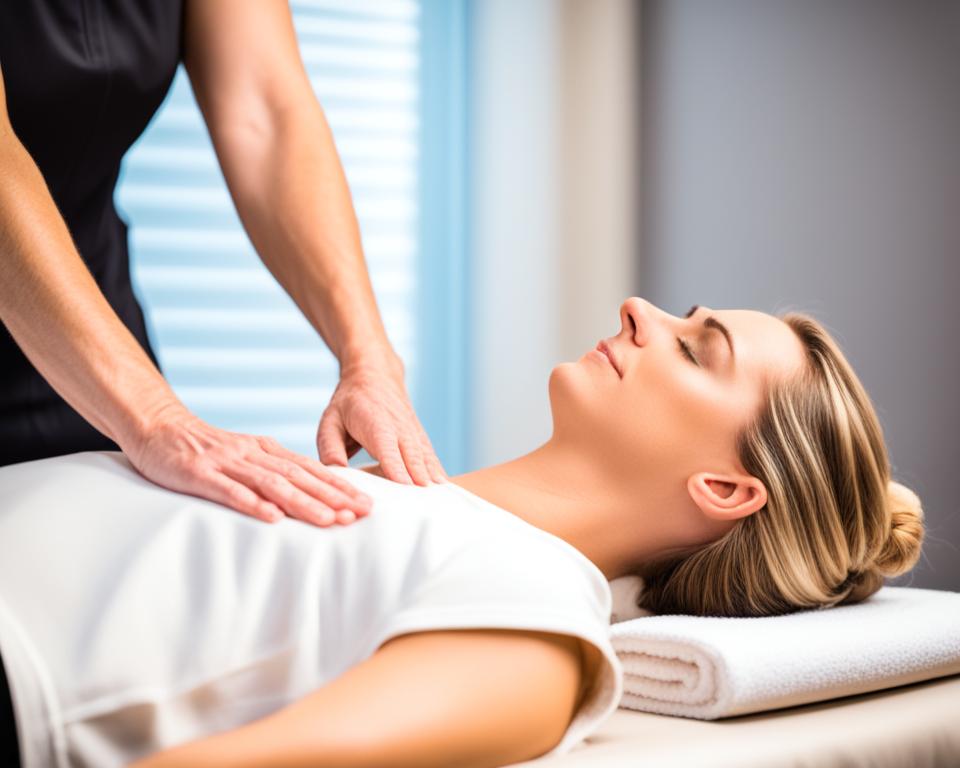
Feeling sudden, intense back pain or very tight muscles can stop you in your tracks. It’s called a back spasm. These episodes can really mess with your daily life and health. This article looks into what causes these back spasms, their symptoms, and how to treat them effectively. It aims to give you the know-how to handle this issue.
Back spasms come from stress or an injury to the back muscles. We’ll look at how the back muscles and spine are connected. This understanding helps us know why back spasms happen. They can be due to muscle strain, lifting things the wrong way, or health issues.
Next, we’ll talk about how back spasms show up. You’ll learn about signs like sharp back pain and muscle tightness or stiffness. We’ll also stress the need to get a proper check-up. Physical exams and tests can help pinpoint the issue.
This article offers a wide view of treating back spasms. This includes first-aid, medicines, and other ways to help. Rest, cold or heat therapy, painkillers, and even meds from a doctor are just some options. With this info, you’ll understand how to tackle back spasms from different angles.
Then, we’ll look at how to keep back spasms at bay. This means the right way to move, having a good setup at work, and ways to cope with stress. These steps can lower your chances of dealing with back spasms. So, you can live better without this issue interrupting your days.
Finally, we talk about when to see a doctor and how to handle ongoing back spasms. This article’s goal is to arm you with what you need. It’s about empowering you to take charge of your back health. With the right information and steps, you can beat the tough effects of back spasms.
Read interesting things at : web-quanto
Key Takeaways
- Back spasms are sudden, involuntary contractions or tightening of the back muscles, often caused by strain or injury.
- Common causes include muscle strain, improper lifting techniques, and underlying medical conditions.
- Symptoms include sudden, intense back pain and muscle tightness or stiffness.
- Treatment options range from first-aid measures to medical treatments and complementary therapies.
- Preventing back spasms involves maintaining proper body mechanics, ergonomic workstations, and stress management.
Understanding Back Spasms
Back spasms are sudden, involuntary muscle contractions in the back. They cause intense pain, stiffness, and reduce how well you can move. The back’s various muscles, tendons, and ligaments support the spine and help you move.
What Are Back Spasms?
Back spasms cause muscles in the back to suddenly and tightly contract. This leads to severe pain, stiffness, and limited motion. These symptoms can greatly affect someone’s day-to-day life.
Anatomy of the Back Muscles
The main back muscles are the erector spinae, latissimus dorsi, and trapezius. They help support the spine, move your body, and keep good posture. Knowing about these muscles is key to understanding back spasms.
Common Causes of Back Spasms
Back spasms can happen for many reasons. These include overusing muscles, lifting things the wrong way, and certain health issues. It’s important to know these causes to prevent and manage back spasms better.
Muscle Strain or Overuse
Too much strain or overuse of muscles is a big cause. Doing hard physical work, like lifting heavy items or pushing your body too hard, can tear back muscles. This leads to spasms. Bad posture and staying in one position for a long time can make it worse.
Improper Lifting Techniques
Lifting things wrongly is a common reason for back spasms. When you bend at the waist to lift, instead of using your knees, it’s bad for your back. Always lift heavy stuff by keeping your back straight and using your legs.
Underlying Medical Conditions
Sometimes, an illness could be causing your back spasms. Things like a herniated disc, arthritis, or a pinched nerve might be the issue. These can lead to swelling, nerve pain, and tight muscles, which then cause spasms.
Symptoms of Back Spasms
Back spasms often start with a sudden, intense pain at your back. You might feel your muscles really tight or stiff, too. This can affect one spot or spread all over your back. It makes moving hard and can stop you from doing regular activities.
Sudden, Intense Back Pain
The telltale sign of a back spasm is a quick, sharp pain in your back. This pain can be very strong and might get worse if you move wrong. It could even travel to your hips, legs, or shoulders, depending on the spasm’s spot and how bad it is.
Muscle Tightness and Stiffness
Back spasms also bring on muscle tightness and stiffness. Your movement can be limited, making things like bending or standing hard. The area might be sore to the touch, adding to your discomfort.
Diagnosis and Evaluation
Healthcare providers first conduct a comprehensive examination to diagnose back spasms. This exam includes feeling the affected area, checking the patient’s movement, and noting their posture and how they walk.
The health expert aims to find areas where the patient feels tender, has tight muscles, or moves poorly. All these signs could lead to the cause of the back spasms.
After the physical examination,
imaging tests
Health professionals might also ask for imaging tests like X-rays, MRIs, or CT scans. These scans are used to find any hidden structural issues or diseases that might be behind the back spasms.
For example, an X-ray can show if there’s arthritis or a herniated disc. Meanwhile, an MRI offers a detailed view of the back’s soft tissues and nerves. Knowing what’s causing the back spasms helps in creating a more direct, successful treatment plan.
First Aid for Back Spasms
When a back spasm hits, you can use several first-aid steps to help. The main points are to rest, use cold and heat therapy, and take pain meds. These steps can lessen the pain.
Rest and Immobilization
First, rest is crucial when you’re dealing with a back spasm. Avoid heavy activities that could make the spasm worse. Try to get comfortable by either lying down or finding a good sitting position. Stop any physical work until the spasm goes away.
Cold and Heat Therapy
Using cold therapy helps by reducing swelling and numbing the pain. Apply an ice pack or cold compress to the sore area. Heat therapy, on the other hand, helps the muscles relax and increases blood flow. This can ease healing and reduce tension.
Over-the-Counter Pain Relievers
Acetaminophen or ibuprofen, which are over-the-counter, can help with the pain. They lessen inflammation and muscle tightness. This brings about sore relief.
Medical Treatment Options
If first-aid measures don’t fully ease your pain, doctors might suggest other treatments. They could prescribe drugs like muscle relaxants or anti-inflammatory meds. These can lessen muscle spasms and make you feel better.
Prescription Medications
Drugs such as muscle relaxants and anti-inflammatory medicines work wonders against back spasms. They target the muscle tension and swelling well. By tackling these main issues, these prescription medications can stop the cycle of spasms. They bring much-needed relief to those with severe or long-lasting back pain.
Physical Therapy
Physical therapy is also very helpful for back spasms. It aims to boost your flexibility and make your back muscles stronger. Plus, it looks into what’s causing the spasms. Using stretches, strength exercises, and manual therapies, therapists can help your muscles work better. This helps stop future back spasms too.
Injections
In particular situations, doctors might suggest special injections for more direct relief. Epidural steroid injections or trigger point injections are examples. They focus on the hurt area, cutting down on swelling and blocking pain signals. This makes them a more targeted method for easing muscle spasms and the pain that comes with them.

back spasms
It’s important to know what causes
back spasms
. These can be from tough physical work, not sitting right, stress, or health issues. Knowing this helps us avoid or reduce
back spasms
Identifying Triggers
Looking at what we do, how we sit, and our habits before
back spasms
happen is key. This may point to triggers like:
- Doing hard physical activities or sports
- Sitting or standing with bad posture
- Feeling a lot of stress or worry
- Health problems like arthritis or disc issues
Lifestyle Modifications
Once we figure out our triggers, we can change some things to prevent more
back spasms
. Ways to do this include:
- Keeping good posture by standing tall and sitting straight
- Using stress relief methods like meditation or yoga to loosen up
- Exercising a bit every day to make your back muscles stronger and your body more flexible
Working on both finding triggers and changing our lives can help dodge
back spasms
Exercise and Stretching
Adding exercise and stretching to your plan can manage back spasms. The right exercises and stretches boost blood flow, relieve muscle stress, and help the spine. This leads to reducing and preventing back spasms.
Low-Impact Aerobic Exercises
Choose low-impact aerobic exercises like walking, swimming, or cycling. They improve blood flow and cut muscle stress without hurting your back. These activities are great for heart and muscle health.
Strengthening Exercises
Pick strengthening exercises for your core and back to aid in managing spasms. Strengthening the spine’s support muscles helps you sit straighter, stay stable, and boost back health. Planks, bridges, and using resistance bands are good examples.
Stretching and Flexibility
Do stretching and flexibility routines often. They add in more movement and lower muscle tightness and spasms. Focus on easy stretches for the back, hips, and hamstrings to loosen up muscles for better movement. This lowers painful spasms chances.
Complementary and Alternative Therapies
Aside from regular treatments, some folks might ease back spasms with different therapies. These methods look at the whole person. They might help in ways other than just stopping pain.
Massage Therapy
Getting a massage can really help work out back spasm issues. It helps the muscles loosen up and increases blood flow. A good massage therapist can focus on tight spots and help reduce spasm chances.
Acupuncture
Acupuncture is an ancient Chinese method that can relieve back pain. By poking certain points, it loosens tense muscles and gets energy flowing again. This can cut down on spasms, too.
Chiropractic Care
These doctors help make sure your spine is straight. For some with back spasms, it works really well. By fixing the spine, they can reduce muscle tightness. This often softens spasm issues.

Preventing Back Spasms
To beat back spasms, it’s smart to take action early. You can do this by moving correctly, setting up your workspace the right way, and handling stress well. This helps cut down on muscle strain and the risk of serious back pain.
Proper Body Mechanics
Good posture and careful lifting can stop back spasms. Make sure your back is straight, your shoulders are back, and you’re using your core when standing or sitting. Use your knees and hips to lift, not your back. This spreads the weight and stops you from twisting your back abruptly.
Ergonomic Workstation
Setting up your workspace the right way can lower strain on your back. Tweak your desk’s height, use a chair that supports your lower back, and line up your computer screen at eye level. These tips keep your neck and shoulders in line. Taking breaks and stretching during work can also ease muscle tension and help avoid back spasms.
Stress Management
Stress does more than just mess with your mind. It can tighten your muscles and make inflammation worse. Lower stress with things like calming exercises, mindfulness, or taking breaks. Managing stress healthily is a great way to stop back spasms from happening.
When to Seek Medical Attention
Back spasms can often be dealt with using self-care and basic over-the-counter meds. But in certain cases, seeing a doctor is essential. If the pain from spasms is severe or doesn’t go away with home treatments, it’s best to get medical advice.
If you face neurological signs like tingling, weakness, or numbness in your legs or feet, go to the doctor right away. These symptoms might point to a bigger health issue.
Living With Back Spasms
Dealing with back spasms often means facing big challenges. But, there are ways to cope and manage the situation. It’s important to create a coping strategy to deal with the pain and discomfort. Developing this plan can help in handling the ups and downs of back spasms.
Coping Strategies
Relaxation methods like deep breathing, meditation, or yoga can lower stress and anxiety. These things can make back spasms worse. It’s also helpful to pace yourself and break tasks into smaller parts. This prevents doing too much at once, helping avoid a spasm.
Keeping a positive attitude is key. Focus on what you can change, not what you can’t. This mindset is a strong way to cope with back spasms.
Support System
Having a strong support system is crucial for those with back spasms. Friends, family, and doctors can be a great help. They can offer emotional support and share useful resources. Support groups, whether in-person or online, also connect you with others in the same boat. This builds a sense of community and understanding.
By combining coping strategies and having the right support, dealing with back spasms becomes easier. It can lead to an improvement in your life quality.
Conclusion
Back spasms are both common and can greatly affect your life. It’s key to know why they happen, the signs, and how to treat them. By using different methods like first-aid, seeing a doctor, changing your daily habits, and trying other therapies, you can ease back spasms. This also helps stop them from happening again.
Getting medical advice when you need it and finding ways to cope are vital for those with back spasms. It can help improve how they live. Targeting the reasons behind the spasms, easing the signs, and taking a wide approach to treating them are essential. This can lead to better moving ability, less pain, and feeling healthier.
In the end, the secret to handling back spasms is deep knowledge, trying different treatments, and changing your lifestyle to help your back muscles. Having a good plan lets you take charge and improve your life despite back spasms.






